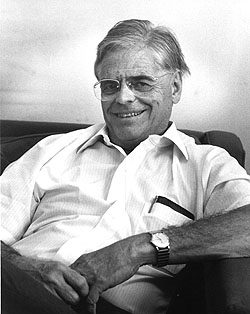Robert R. Wilson, Cornell physicist and designer of particle accelerators, died Jan. 16 in Ithaca
By Roger Segelken

Robert Rathbun Wilson, the experimental physicist who designed some of the world's most powerful particle accelerators used to study the fundamental nature of matter, died Jan. 16 at home in Ithaca. The former director of the Cornell Laboratory of Nuclear Studies and of the Enrico Fermi National Accelerator Laboratory (Fermilab) was 85.
Wilson joined the Cornell physics faculty in 1947 after heading the Manhattan Project's Experimental Nuclear Physics Division in Los Alamos during World War II and serving briefly on the faculty of Harvard University.
At the Cornell Laboratory of Nuclear Studies, he designed a series of increasingly energetic particle accelerators that led to construction of the Cornell Electron-positron Storage Ring (CESR) at the facility that now bears his name, the Wilson Synchrotron Laboratory.
Wilson took a leave of absence from the Cornell faculty in 1967 to assume directorship of the National Accelerator Laboratory, where what was to be the highest-energy particle accelerator was under construction in Batavia, Ill. Under Wilson's leadership, the four-mile-circumference, 400 GeV (400 billion electron volt) machine was completed on time and under budget. He served as the Fermilab director until 1978 and returned to live in retirement in Ithaca. Cornell named him professor emeritus of physics in 1980.
According to fellow physicist Dale Corson, the Cornell president emeritus who knew Wilson as a graduate student at the University of California at Berkeley and at Los Alamos and who recruited the young professor to Cornell from Harvard, Wilson was more than "one of the top, world-class machine designers. He was a top-notch physicist as well."
Announcing Wilson's death to colleagues around the world, Cornell physics Professor Karl Berkelman, the fourth director of the Laboratory of Nuclear Studies, said: "Bob Wilson was one of the leading architects of the golden age of high-energy particle accelerators. His motivation throughout his career was the basic physics that one could learn from the collisions of high-energy particles, and he participated in many important experiments."
Wilson was born March 4, 1914, in Frontier, Wyo., and he later recalled a simpler time when physicists did not know the scores of subatomic particles that his machines would reveal, saying: "We had only electrons and protons, and you could put those together into atoms in various ways and make the whole universe. It was a very simple theory that even a dope could understand. I decided then that I wanted to go into physics."
The student physicist was admitted to Berkeley in 1932 and published his first original research in the journal Physical Review as a college senior. He earned the A.B. degree cum laude (1936) and Ph.D. (1940), studying with Nobelist Ernest O. Lawrence. At Princeton University in 1941, Wilson invented an electromagnetic method for separating the isotopes of uranium, the so-called Isotron method.
In 1943 Wilson and colleagues from Princeton moved a Harvard cyclotron to Los Alamos, N.M., where the Manhattan Engineering Project was beginning, and tested the fission process with the aim of designing an atomic weapon. While leading a key scientific group at the bomb project, Wilson also was active in community life of a growing Los Alamos, serving as the chairman of the community's town council.
As the war was ending, Wilson helped establish the Federation of American Scientists and served as its chairman in 1946. Most of his brief tenure at Harvard was spent at Berkeley, where he was designing a new cyclotron for Harvard. He came to Ithaca in the winter of 1947.
Among the numerous honors to Wilson during his 40-year career in particle physics were the National Medal of Science (1973); the Enrico Fermi Award (1984) from the U.S. Department of Energy; as well as election to the National Academy of Sciences, the American Academy of Sciences and the American Philosophical Society. In 1985 he was elected president of the American Physical Society.
A Cornell physicist who succeeded Wilson as director of the Laboratory of Nuclear Studies, Professor of Physics Emeritus Boyce McDaniel, said his late colleague Ð a part-time sculptor with works at Princeton, Fermilab and Cornell Ð also should be remembered for his interest in artistic and scientific beauty.
"Bob built accelerators because they were the best instruments for doing the physics he wanted to do. No one was more aware of the technical subtlety of accelerators, no one more ingenious in practical design, no one paid more attention to their aesthetic qualities. He thought of accelerator builders as the contemporary equivalent of the builders of the great cathedrals in France and Italy," McDaniel said, "but it was the physics potential that came first."
But in 1969, when Wilson was in the hot seat testifying before the Congressional Joint Committee on Atomic Energy, Sen. John Pastore demanded to know how a multimillion-dollar particle accelerator improved the security of the country. Wilson said the experimental physics machine had "nothing at all" to do with security, and the senator persisted.
"It has only to do," Wilson told the lawmakers, "with the respect with which we regard one another, the dignity of men, our love of culture. It has to do with: Are we good painters, good sculptors, great poets? I mean all the things we really venerate in our country and are patriotic about. It has nothing to do directly with defending our country except to make it worth defending."
Wilson is survived by his wife of 59 years, the former Jane Inez Scheyer; three sons, Daniel R. Wilson of Indianapolis, Jonathan H. Wilson of Columbus, Ind., and Rand E. Wilson of Boston; four grandchildren; and a sister, Mary Jane Greenhill of Palos Verdes Estates, Calif.
Media Contact
Get Cornell news delivered right to your inbox.
Subscribe